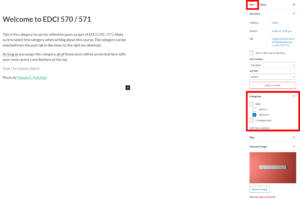What education technology issue, topic, or theme are you most interested in?
What does the literature say about the issue, topic, or theme identified?
“The Science Behind Change” – Katie Novak (Jeff Utecht, 2023).
One of my favourite education podcasts of all time is called, “Preparing Students For Their Future Not Our Past” by Jeff Utecht. Listening to it two years ago, I found myself looking at the education system with a more critical lens. I found myself wondering if collectively teachers were preparing students well enough for the rapidly changing social environment; specifically, with regards to technology integration in the classroom and preparing students for the workforce. Jeff calls it the “fourth industrial revolution” in this Podcast, referring to the time we live in as the “knowledge-economy” (Jeff Utecht, 2020). Essentially, he suggests that the way we used to learn is out-dated, suggesting that the education system was founded on a “just in case” model of learning, where we were taught everything… “just in case” we needed to know it (Jeff Utecht, 2020). Now, information is everywhere and more easily accessible. So we should, realistically, be changing the education system. I’m curious about this concept of education reform and thus stems my interest in pursuing this topic more deeply.
Building on this curiosity, I recently listened to another Podcast in his series, called, “302: Honoring the complexities of what it means to be an educator with Dr. Novak and Dr. Rodriguez” (Jeff Utecht, 2023). In this Podcast, he interviews Dr. Katie Novak and Dr. Kristen Rodriguez about their new book, In Support of Students: A Leader’s Guide to Equitable MTSS. I had yet to hear of this term, MTSS. A Google search defined MTSS as, “A multi-tiered system of supports (MTSS) is a proactive and preventative framework that integrates data and instruction to maximize student achievement and support students social, emotional, and behavior needs from a strengths-based perspective” (MTSS Definition – Google Search, n.d.)
Many aspects of the Podcast resonated with me, which I will discuss, but what I want to talk about is more holistic. The entire approach the two Podcast guests were discussing made me recognize parallels in their research approach to what I am reading about in our textbook for 515, “Educational Research – Quantitative, Qualitative and Mixed Approaches” by R Burke Johnson and Larry Christensen.
In the textbook, they describe action research as being “focused on solving specific problems that local practitioners face in their schools and communities” (Johnson & Christensen, 2014, p. 116). Action research is a combination of research and action. It generates local knowledge, and it often results in changes in practices. Action research is used to try out new strategies and practices, and the researcher carefully measures and observes the outcomes and consequences of these actions” (Johnson & Christensen, 2014, p. 116). As I’m listening to the podcast, and how the authors describe their work collectively with teachers, empathizing with them and working alongside them to enhance their teaching experience – it made me realize this might be what our textbook is describing. They have helped create strategies, what they deem to be four simple guiding practices, that will create a more equitable experience for learners. These practices will also create ease and clarity for teachers.
In the Podcast, Kirsten Rodriguez describes this aspect of their research: “I think part of the work around systems change is identifying a few key levers that we can pull, a few recipes that we can make available to this particular district that is lacking, that with those few, we can make something really amazing that everyone will benefit from” (Jeff Utecht, 2023). She goes on to say, “Designing deeper learning experiences. We are providing high quality professional development. We are adopting high quality instructional resources. We are using data authentically, and deliberately and meaningfully so that we can fast meet the students needs where they are and bring them to where they’re going. All of those actions are essentially the different ingredients, the things that we have to do, so that we can build a multi tiered system” (Jeff Utecht, 2023). This is describing actionable change, even changing the fundamental system itself, so that teachers and students can thrive. The message of their podcast sparked interest in me, that they are pursuing the very educative reform and adaptation that I had been searching for.
In our textbook, they describe critical action research as that which “emphasizes the empowerment of those with little power in their communities and society.” It further defines it as an “openly transparent form of ideology-driven research designed to emancipate and reduce oppression of disadvantaged groups in society” (Johnson & Christensen, 2014, p. 125) In comparison to the Podcast, Novak and Rodriguez say, “We cannot serve all students until we design learning that embraces the brilliance and loved experiences and identifies of our black and brown students, learners with disabilities, multi-lingual learners, students who are economically disadvantaged, LGBTQ students, students who experience trauma, and students who need more social, emotional and behavioural or academic support than we currently provide” (Novak & Rodriguez, 2023, p. 79).
Critical Action Research helps recognize marginalized individuals and groups of people, and makes actionable strategies and practices to create equity. I would then I would therefore classify Novak and Rodriguez’s work as both Participatory / Collaborative Action Research and Critical Action Research.
Reference List:
Johnson, R.B., & Christensen, L. (2014). Educational Research: Quantitative, Qualitative and Mixed Approaches (5th ed., pg 125).
Novak, K., & Rodriguez, K. (2023). In Support of Students: A Leader’s Guide to Equitable MTSS (1st ed.). Jossey-Bass.
Utecht, J. [Shifting Schools Podcast]. (2023, September 23). Honoring the complexities of what it means to be an educator with Dr. Novak and Dr. Rodriguez[Podcast]. https://www.youtube.com/watch?v=u6KPqdvSgBo
Utecht, J. [Shifting Schools Podcast]. (2020, June 24). Preparing Students for Their Future Not Our Past [Podcast]. https://www.youtube.com/watch?v=ithf3LmyAFs


Recent Comments